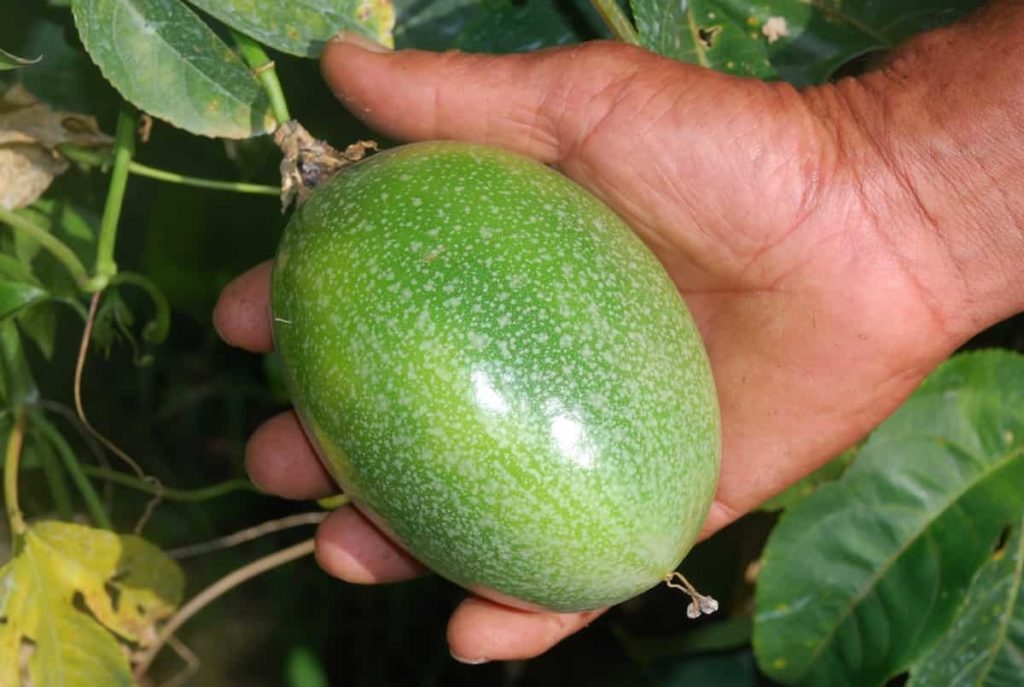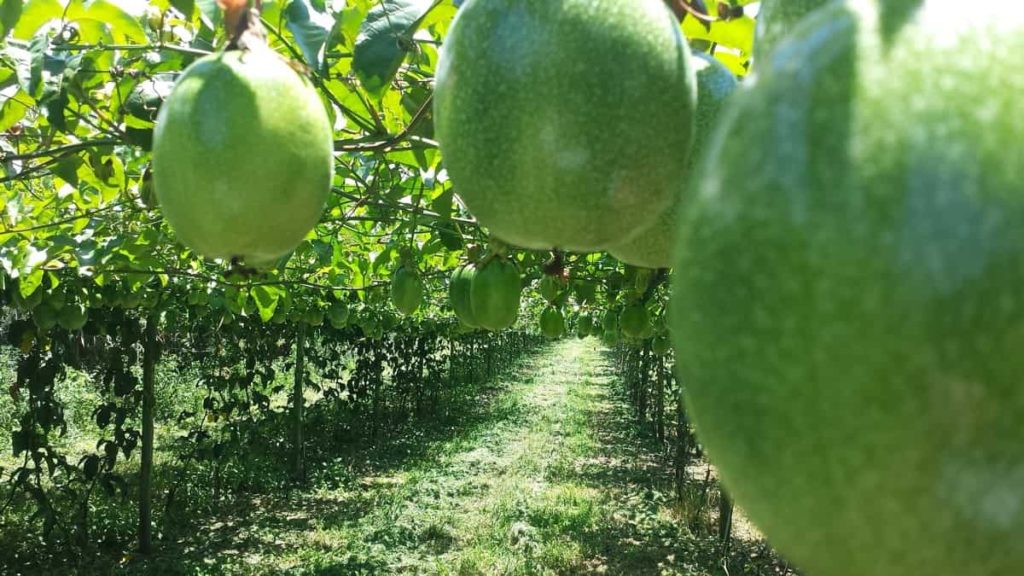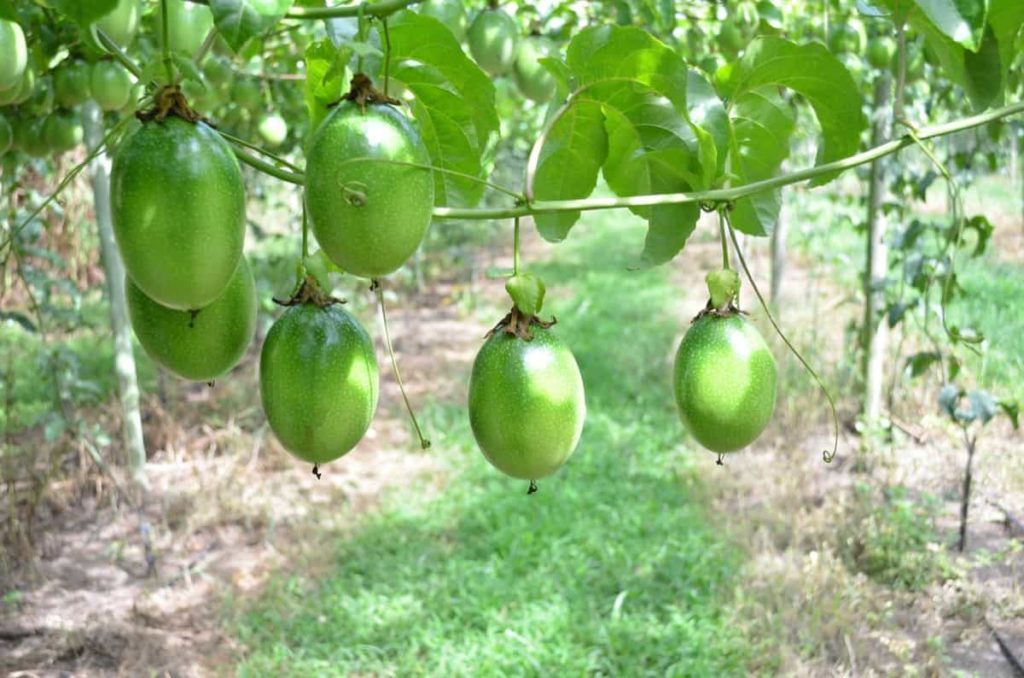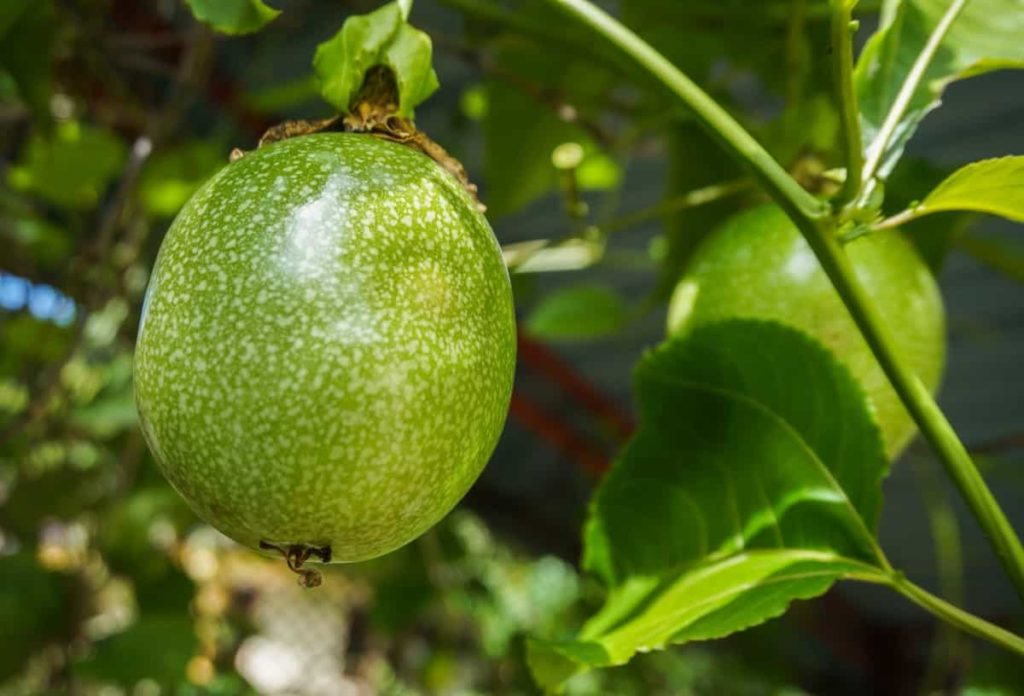The Passion Fruit plant is a heavy feeder that needs proper space and rich, healthy soil. If the soil is dry and compact or more saturated, has a wrong pH, or lacks organic material, your Passion Fruit plant may fail to thrive. Balanced, healthy soils that are high in organic nutrients will do wonders for your garden, whether it’s especially for the Passion Fruit or many of your plants. Let’s check out the best fertilizer for Passion Fruit

One of the main tips for improving your Passion Fruit crop is to ensure that the vine has good access to all nutrients and track the elements it needs for healthy growth. It is important at the time of planting and throughout the life cycle. Fertilizers play a crucial role in the life cycle of Passion Fruit. If you have fruit-bearing Passion vines, you need to apply a lot of fertilizer. But you need to keep in mind that all kinds of fertilizers and not all times are suitable for this plant.
The vine takes a large number of different nutrients at different stages. For example, the plant requires very little amount of potassium during its vegetative growth levels but requires high amounts of nitrogen and phosphorus. So, you need to apply different fertilizers at different stages of Passion Fruit. Be aware that high nitrogen-ratio fertilizer will encourage leaf growth, so be sure to find one with a good proportion of phosphorus to support flowers.
It is not only important to know what fertilizer to use, how and when to apply it to the Passion Fruit, you should also know signs of nutritional deficiency. Thus, you will know when to reinforce the application of certain nutrients. Nitrogen deficiency is evidenced by very thin branches, yellow leaves leading to a lack of chlorophyll. This last sign begins to appear to a greater extent in the old leaves.
Small leaves will have a lighter-than-normal green color. In the case of phosphorus, you can notice the lack of it if there are spots in the old dark green leaves that combine and form a full yellow sheet. Also, the petioles and ribs are light red with very distant leaves, weak and thin branches. When there is a shortage of potassium, you will see that the leaves are turned down. Both the number and thickness of the branches are reduced.
In case you miss this: Passion Fruit Gardening for Beginners, How To Start

Best fertilizer for Passion Fruit
Compost manure for Passion Fruit
Compost
The best way to produce healthy, productive plants is to prepare the planting site before starting seeds or seedlings. Using composted materials is a great way to modify the plantation site and avoid subsequent losses, such as a lack of organic materials and available nutrients, which can cause poor growth and low productivity.
Aged manure
Manure is nutrient-dense because it comes from organic materials, but beware because using fresh manure can burn plant roots. Aged manure and compost can be added together, and can be worked in the soil to feed plants in the growing season. Chicken manure is better if you have access. you can spread it two to three inches deep on the ground above where you plan to plant in spring. Do so in the fall or winter to give several months to break down. Ready to apply fertilizer after 7 to 9 months. Do not collect the manure of dogs, cats, or such types of animals.
Organic fertilizers for Passion Fruit
Bone meal
Phosphorus is essential for flowering plants, such as the Passion Flower. Without it, buds will not be formed and ultimately there will be no Passion Fruit for harvesting. Bone meal granules can be broadcast in early spring as per package instructions; a large cup spread over the plant roots area generally should be enough for three to four months of feeding. Bone meal can also be combined with aged manure for an additional boost that will feed the plant for both leaves and flowers.
In case you miss this: Passion Fruit Growing Tips, Techniques, and Secrets

Blood meal
Passion Fruit regularly needs blood and bone meal and potash.
Homemade fertilizers for Passion Fruit
Baking soda
Baking soda is a simple modification to increase the pH faster and more effectively. Baking soda can be added to the soil before or after planting, add about a tablespoon to just one gallon of water, mix well, and spray the soil freely. Lime can also be used to increase soil pH. While baking soda is relatively soft and harmless, lime should be handled with greater care.
Sphagnum peat moss
Sphagnum peat moss can be added to the soil surface as a two to three-inch deep fin and gently in, if your bull has already been planted, or can be cultivated up to a depth of about six inches before planting. Peat moss can reduce your pH in soil by up to two years.
Coffee grounds
Black tea adds a small amount of acidity to the soil. Add spent bags or grounds to your compost pile, or spread them to the place where your vine is planted.
Banana peels
Increase the amount of potassium you feed to plants to support fruit production, especially if soil testing results show lower potassium levels. Do this by adding Banana peels to your compost pile, which can make them rot for a few weeks before spreading the fertilizer at the base of your vine.
Natural fertilizers for Passion Fruit
Tea leaves
Tea leaves also add organic matter to the garden and can help prevent the growth of certain types of weeds. You can add tea to the garden at any time, but spring is the best when new developments are taking place.
Greensand
Greensand can be broadcast over the soil, spreading about two cups in early spring, and racking in the top layer of soil. An additional benefit of using greensand is water retention, it keeps moisture and can keep the soil moist for a slightly longer period.
Grass clippings
Grass clippings are rich in nitrogen and mulching will prevent the growth of weeds. Mulching will also maintain soil moisture for a long time.
In case you miss this: Growing Passion Fruit in Containers from Seed, Cuttings

Liquid fertilizers for Passion Fruit
Seaweed
Watering the plant with seaweed emulsion after planting, and then always helping to establish a new plant in a few weeks.
Commercial fertilizers for Passion Fruit
Commercial fertilizers of all purposes (with the same NPK ratio) are not bad for the Passion Fruit vine. Besides, the fertilizers which are 12-24-12 or 10-30-10 NPK are good enough for this plant. Remember that a higher proportion of nitrogen encourages leaf growth rather than flowering. These are the fertilizers for the Passion Fruit.
- Granular fertilizer of formula 10-30-10 or 12-24-12
- Urea
- Potassium sulfate
- Diammonium phosphate
- Organic fertilizers like manure and compost
We cannot talk about how to fertilize the Passion Fruit without knowing the behavior of its roots first. This will ensure that the application is more efficient, otherwise, the fertilizer will be lost. 90% of the roots are 0.15 to 0.50 meters deep. In addition, 70% are located about 0.60 meters from the trunk. Both factors are necessary to know where to place fertilizer for good distribution in all roots.
Passion Fruit fertilizer schedule
- Fertilizing of Passion Fruit should start before transplant. Once Passion Fruit plants are established, the plant should be fertilized according to the demand for nutrients. For example, demand for nitrogen increases during vegetative growth. While other nutrients like phosphorus, potassium, and calcium are more important during the growth of flowers and fruits.
- It is very important to fertilize the Passion Fruit for proper growth of the fruit. Therefore, it should start from the time of planting. Once sowing is done and until the seedlings reach 10 centimeters, they should be fertilized with a 10-30-10 or 12-24-12 NPK ratio. As you will see, these formulas have a higher phosphorus concentration, which helps improve the growth of roots in the early stages of the plant.
In case you miss this: Passion Fruit Seed Germination, Period, Temperature

- Moreover, the soil in which the germination occurs has to be enriched with good organic matter. Once the plant exceeds 10 centimeters in height, you can start with the foliar fertilization every 10 days with the following mixture: 10 grams of urea per liter of water, 10 grams of potassium nitrate per liter of water.
- Between 3 or 4 weeks from the transplant, it is recommended to apply decomposing organic matter to the soil. It is also a good time to study soil to schedule more specifically fertilization.
- Once Passion Fruit is transplanted and with 2 months regularity, edaphic fertilization is done with the following formula Urea 35%, potassium sulfate 35%, and Diammonium phosphate 20%.
How to fertilize Passion Fruit in pots/containers
Despite being relatively little care, the Passion Fruit plant does like nutrient-rich soil mix. Most of anything in nitrogen will mostly promote green, leafy growth so you can choose fertilizer to provide some balanced nutrition. Once or twice a year (usually in the late spring and summer) put some homemade fertilizer around the plant base. Later mulch around the base using any dead leaves from the vine. Mulching helps protect the root system.
Keep these hungry vines weed-free, water well (especially when it rains a little), and be fed from spring to summer. Use pelletized citrus food or chicken manure. Before adding manure, water plants then spread it around the base of the stem and along the area where the roots are growing. After feeding in the spring, spread organic mulch such as manure or aged cow manure 2 to 3 centimeters deep.
Frequently asked questions about fertilizers for Passion Fruit
Why is my Passion Fruit plant not flowering?
The most common reason for the lack of flowers is too much nitrogen and very little potassium. Especially if you apply too much nitrogen-based fertilizer, will lead to vegetative growth at the expense of flowers. Dehydration leads to less flower growth. Lack of sunlight can also be a reason why the plant does not flower.
In case you miss this: Top 30 Quick Growing Fruits In Containers/Pots

My Passion Fruit Flowering but why not give fruit?
Too much fertilizer can also often cause flowers to fall. Fruit should appear in the summer months. Water your vines well during fruit production and apply mulch around the root system to preserve moisture in the soil.
Is the Seasol good for the Passion Fruit?
Fertilize your Passion Fruit plant with Seasol or granular fertilizer for every6 to 8 weeks.
Why are my Passion Fruit leaves turning yellow?
Deficiency of iron, magnesium, molybdenum, zinc, or manganese can also cause yellowing Passion vines. Yellow will appear especially between leaf veins. Similarly, lack of nitrogen, sulfur, or potassium can cause yellow leaves on Passion Fruit plants.
- Where to Place Indoor Plants in Your Home
- How to Grow Tomatoes Organically at Home: A Comprehensive Guide
- Organic Gardening on a Budget: Low-Cost Methods and Materials
- Gongura Seed Germination and Planting Methods
- Cabbage Seed Germination and Selection
- Broccoli Seed Germination and Selection
- Asparagus Seed Germination and Variety Selection
- Seasonal Flower Gardening: Best Practices for Spring, Summer, Fall, and Winter
- How to Grow Hibiscus from Flower
- Plantation Ideas for Home Decoration: A Beginners Guide
- Flower Garden Designs and Layouts for Beginners
- Planting and Spacing Techniques in Papaya: A Beginner’s Guide
- Growing Gold: Essential Techniques for Planting Pineapples
- How to Make Kalanchoe Plant Bushy: Home Remedies and Solutions
- 11 Reasons Why Your Gardenia is Not Blooming: Home Remedies and Solutions
- Eco Elegance: The Guide to Designing a Drought-Tolerant Landscape
- Gardening on a Slope: Strategies for Hillside Landscaping
- Nourish and Flourish: Top Organic Mulches for Thriving House Plants
- Everything You Want to Know about Indian Mogra Flower: Discover Uses and Growing
- Green Thumb Success: Expert Tips for Cultivating Greenhouse Pumpkins All Year Round
- Maximize Growth & Flavor: The Ultimate Guide to Companion Planting in Herb Gardens
- How to Control Rhododendron Problems Naturally: Home Remedies and Organic Ways to Fix Them
- Natural Magic: The Remarkable Benefits of Cinnamon for Plants
- Best Steps to Revive Dying Tulip with Natural and Organic Treatment
- 10 Reasons Why Your Angel Trumpet is Not Blooming: Remedies and Treatment
- How to Fix Periwinkle Leaf and Flower-Related Problems: Natural Remedies and Solutions
- How to Fix Zinnias Leaf and Flower Problems: Discover Natural and Home Remedies
- Organic Steps to Induce Lemon Tree Flowers: A Comprehensive Guide
- Bloom Booster: Crafting the Perfect Homemade Bougainvillea Fertilizer
- Optimizing Growth: A Guide to Applying NPK Fertilizer for Potted Plants
- 10 Best Homemade Fertilizers for Rubber Plant: DIY Recipes and Application Method
- How to Boost Female Pumpkin Flowers: Effective Steps for More Flowers and High Yields
- Transform Your Indoor Garden: Top Benefits of Pink Salt for Houseplants
- 10 Best Homemade Fertilizers for Peacock Plants (Calathea): Easy DIY Guide
- Unlock Blooms: 9 Reasons Why Your Potted Chrysanthemum is Not Blooming
- 8 Reasons Why Your Potted Hibiscus is Not Blooming: Fix it with Simple Solutions